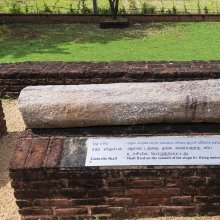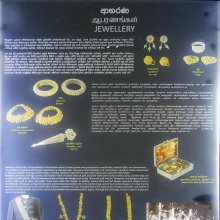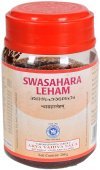Tanka, Ṭaṅka, Taṅka, Ṭaṃka, Ṭanka, Tamka, Tāṅkā, Ṭankā: 28 definitions
Introduction:
Tanka means something in Hinduism, Sanskrit, Buddhism, Pali, the history of ancient India, Marathi, Jainism, Prakrit, Hindi, Tamil. If you want to know the exact meaning, history, etymology or English translation of this term then check out the descriptions on this page. Add your comment or reference to a book if you want to contribute to this summary article.
Images (photo gallery)
In Hinduism
Shilpashastra (iconography)
Source: Google Books: Elements of Hindu iconographyThe small chisel used by the stone-mason is called the ṭaṅka.
Source: Red Zambala: Hindu Icons and Symbols | Inner Circle IVA weapon which is unique to Murugan is the Ṭaṅka or chisel used by sculptors and stone-masons — śilpis. It represents the work that needs to be done on ourselves in order to manifest our true essence nature. – The figure is already present in the stone, but it takes the skill of the sculptor to liberate it. In the same way the Jīvātman is present within the body/mind casing, it takes the skill of a sādhaka to reveal it.
Source: Shodhganga: The significance of the mūla-beras (śilpa)Ṭaṅka (टङ्क, “chisel”) refers to one of the several “attributes” (āyudha) or “accessories” of a detiy commonly seen depicted in Hindu iconography, defined according to texts dealing with śilpa (arts and crafs), known as śilpaśāstras.—The small chisel used by the stonemason is called the ṭaṅka.

Shilpashastra (शिल्पशास्त्र, śilpaśāstra) represents the ancient Indian science (shastra) of creative arts (shilpa) such as sculpture, iconography and painting. Closely related to Vastushastra (architecture), they often share the same literature.
Purana and Itihasa (epic history)
Source: archive.org: Shiva Purana - English TranslationṬaṅka (टङ्क) refers to a unit for measurement of weight, corresponding to one-tenth of a pala, according to the Śivapurāṇa 2.1.14:—“twenty full lotuses (kamalā) constitute one prastha measure. A Thousand Bilva leaves (bilvapatra) constitute half a prastha. Petals of lotuses (śatapatra), a thousand in number constitute half a prastha. Ten ṭaṅka weight constitutes one pala and sixteen palas make one prastha. Flowers for worship shall be weighed in the balance according to this calculation. The worship thus duly performed shall accord all cherished desires. If the devotee worships with no specific desires he will become Śiva himself”.
Source: Shodhganga: Temples and cult of Sri Rama in TamilnaduTanka (also Tuppul) refers to one of the 108 divyadesas according to Priyavaccan Pillai’s compendium of the Ramayana based on the Nalayirativviyappirapantam.—Tanka is the birth place of Desikacarya. The Lord is named but supposed to be of the form of “Light”.

The Purana (पुराण, purāṇas) refers to Sanskrit literature preserving ancient India’s vast cultural history, including historical legends, religious ceremonies, various arts and sciences. The eighteen mahapuranas total over 400,000 shlokas (metrical couplets) and date to at least several centuries BCE.
Vaishnavism (Vaishava dharma)
Source: Acta Orientalia vol. 74 (2013): Historical sequence of the Vaiṣṇava DivyadeśasTaṇkā (Tūppul-Kāñci) refers to one of the 108 Vaishnava Divya Desam (divyadeśas or divyasthalas), located in the topographical division of Toṇṭaināṭu (“Northern Tamil Nadu”), according to the 9th century Nālāyirativviyappirapantam (shortly Nālāyiram).—Tradition would record the Vaiṣṇava divyadeśas or divyasthalas are 108. The divyadeśa is a base of the cult of Viṣṇu in Viṣṇuism [Vaiṣṇavism] tradition. The list of 108 [viz., Taṇkā] seems to have reached maturation by about the early 9th century CE as all the deśas are extolled in the hymns of the twelve Āḻvārs.

Vaishnava (वैष्णव, vaiṣṇava) or vaishnavism (vaiṣṇavism) represents a tradition of Hinduism worshipping Vishnu as the supreme Lord. Similar to the Shaktism and Shaivism traditions, Vaishnavism also developed as an individual movement, famous for its exposition of the dashavatara (‘ten avatars of Vishnu’).
Ayurveda (science of life)
Source: gurumukhi.ru: Ayurveda glossary of termsṬaṃka (टंक):—A unit of Measurement; Synonym of one sana = 3 g of metric units

Āyurveda (आयुर्वेद, ayurveda) is a branch of Indian science dealing with medicine, herbalism, taxology, anatomy, surgery, alchemy and related topics. Traditional practice of Āyurveda in ancient India dates back to at least the first millenium BC. Literature is commonly written in Sanskrit using various poetic metres.
Kavya (poetry)
Source: OpenEdition books: Vividhatīrthakalpaḥ (Kāvya)Ṭaṃka (टंक) is related to the Prakrit ṭaṃkiā, which refers to an “chisel, chisel”, as is mentioned in the Vividhatīrthakalpa by Jinaprabhasūri (13th century A.D.): an ancient text devoted to various Jaina holy places (tīrthas).—Cf. ṭaṃka. (Jacobi 1886 p. 112; ST p. 139); cf. ṭaṅkitvā; CDIAL 5427 gives several meanings (stone chisel, sword, hatchet) of the word and its derivatives in modern languages. In Gujarati, ṭāṃka designates a point, ṭāṃkaṇī, a stake, a peg, and more especially a carpenter’s tool.

Kavya (काव्य, kavya) refers to Sanskrit poetry, a popular ancient Indian tradition of literature. There have been many Sanskrit poets over the ages, hailing from ancient India and beyond. This topic includes mahakavya, or ‘epic poetry’ and natya, or ‘dramatic poetry’.
Shaivism (Shaiva philosophy)
Source: SOAS University of London: Protective Rites in the Netra Tantra1) Ṭaṅka (टङ्क) refers to a “spade”, according to the Netratantra of Kṣemarāja: a Śaiva text from the 9th century in which Śiva (Bhairava) teaches Pārvatī topics such as metaphysics, cosmology, and soteriology.—Accordingly, [verse 11.1-24ab, while describing the appearance and worship of Tumburu]—“[...] [He worships] Deva as Tumburu in the middle of an eight petaled lotus, in the maṇḍala, [starting] in the East, O Devī. [...] Adorning Deva is a white flower and a spade (ṭaṅka-kandala-bhūṣita). [He] holds an elephant hook and noose. Deva [has] a thread with a cakra at the access, hand [held in the] wish-granting and protective [mudrās]. [...]”.
2) Ṭaṅka (टङ्क) refers to a “stone cutter’s chisel”.—Accordingly, [verse 13.25cd-28, while describing the appearance and worship of Viśvakarman]—“Furthermore, [I shall describe] Viśvakarman, the Lord of the world. [He] is bright as a ray of light, risen alone [i.e., from itself]. [Viśvakarman] has [either] two or four arms. [When he has four hands he] bears a stone cutter’s chisel and a book (ṭaṅka—ṭaṅkapustakadhāriṇam) with [his] beautiful right hand. [In the left he holds] a clamp and a cord. [...]”.

Shaiva (शैव, śaiva) or Shaivism (śaivism) represents a tradition of Hinduism worshiping Shiva as the supreme being. Closely related to Shaktism, Shaiva literature includes a range of scriptures, including Tantras, while the root of this tradition may be traced back to the ancient Vedas.
Sports, Arts and Entertainment (wordly enjoyments)
Source: archive.org: Syainika Sastra of Rudradeva with English Translation (art)Ṭaṅka (टङ्क) refers to a unit of measuring the food for Hawks, according to the Śyainika-śāstra: a Sanskrit treatise dealing with the divisions and benefits of Hunting and Hawking, written by Rājā Rudradeva (or Candradeva) in possibly the 13th century.—Accordingly, [while discussing the importance of hawks]: “Now will be described the quantity of their food, the way of tending them at different seasons, their diseases and their cure. Twenty-five ṭaṅkas of fresh flesh is quite enough for a Kuhī, Caraka, Vāja, and Vaharī. The Śaśādas should not be given less, for they are incapable of fasting. [...]”.

This section covers the skills and profiencies of the Kalas (“performing arts”) and Shastras (“sciences”) involving ancient Indian traditions of sports, games, arts, entertainment, love-making and other means of wordly enjoyments. Traditionally these topics were dealt with in Sanskrit treatises explaing the philosophy and the justification of enjoying the pleasures of the senses.
India history and geography
Source: Cologne Digital Sanskrit Dictionaries: Indian Epigraphical GlossaryṬaṅka.—(EI 9, 20; CII 4; ML), name of a coin; cf. Vijayarāja- ṭaṅka, ṭaṅka issued by Vijayarāja; spelt often as ṭaṅkā and in old Bengali as taṅkā; same as śāna also called dharaṇa; a coin in general; regarded as equal to 4 silver fanams; name applied to both gold and silver issues 80 ratis in weight (JNSI, Vol. XXII, pp. 197-98); silver coins of the Delhi Sult8āns—96 or 100 ratis in weight. See JNSI, Vol. XVI, pp. 42-49. Cf. śāśukāni- ṭaṅka, hema-ṭaṅka, raupya-ṭṅka; also ṭaṅka (LP), a copper coin equal to half of a pice. (Chamba), a copper coin equal to (1/20) of a Rupee. Note: ṭaṅka is defined in the “Indian epigraphical glossary” as it can be found on ancient inscriptions commonly written in Sanskrit, Prakrit or Dravidian languages.
--- OR ---
Ṭaṅka.—a coin in general; a silver coin (often one tola in weight); same as śāna; equal to 4 silver fanams, silver coin of the Delhi Suḻtāns, 96 or 100 ratis in weight; same as aṭha- gānī (q. v.); a small copper coin; (1/2) of a rupee. There were gold and copper taṅkas; see hema-ṭaṅka and raupya-ṭaṅka. Cf. ṭāṅk, etc. Note: ṭaṅka is defined in the “Indian epigraphical glossary” as it can be found on ancient inscriptions commonly written in Sanskrit, Prakrit or Dravidian languages.

The history of India traces the identification of countries, villages, towns and other regions of India, as well as mythology, zoology, royal dynasties, rulers, tribes, local festivities and traditions and regional languages. Ancient India enjoyed religious freedom and encourages the path of Dharma, a concept common to Buddhism, Hinduism, and Jainism.
Languages of India and abroad
Pali-English dictionary
Source: BuddhaSasana: Concise Pali-English Dictionaryṭanka : (m.) an instrument to cut stones.

Pali is the language of the Tipiṭaka, which is the sacred canon of Theravāda Buddhism and contains much of the Buddha’s speech. Closeley related to Sanskrit, both languages are used interchangeably between religions.
Marathi-English dictionary
Source: DDSA: The Molesworth Marathi and English Dictionaryṭaṅka (टंक).—ad (ṭaṅka S A weight.) An emphatic particle used with nouns and verbs referring to measures and weights. Exactly to the degree or quantity of; up to the measure or amount of. Ex. hēṃ vajana āṇi tēṃ māpa ṭaṅka āhēta; puṇyācē māpānēṃ dāṇē āṇalē tē ṭaṅka utaralē i. e. Weight with weight; measure with measure.
--- OR ---
ṭaṅka (टंक).—m S A stone-cutter's chisel. 2 A weight equal to four māṣa &c. See under ṭāṅka Sig. I.
--- OR ---
ṭāṅka (टांक).—m (ṭaṅka S) A weight, according to some, of one tōḷā or the seventy-secondth part of a pakkā śēra; according to others, of nine māsē; according to others, of four māsē. 2 The nib of a pen. 3 By melon. A penful of ink. Pr. ṭāṅkā āgaḷēṃ li- hāvēṃ ghāṃsā uṇēṃ jēvāvēṃ Write a nibful over; eat a mouthful under (or less). Hence a very small quantity of a liquor gen. 4 A metal plate with an image of a god impressed. Hence fig. An indispensable person at a feast or rite--who must be invited. 5 (Poetry.) A rupee or any silver coin. 6 (Enhancing particle to kōraḍā) Utterly dried up--a river, tank, well. ṭāṅka guntaṇēṃ g. of s. To be bound by some note of hand passed or writing executed. ṭāṅka māraṇēṃ To set down in writing. ṭāṅkānēṃ (or lēkhaṇīcyā ṭāṅkānēṃ) gaḷā kāpaṇēṃ To kill with the pen.
Source: DDSA: The Aryabhusan school dictionary, Marathi-Englishṭaṅka (टंक).—ad An emphatic particle used with nouns and verbs referring to mea- sures and weights. Exactly to the degree or quantity of; upto the measure or amount of Ex. puṇyācē māpānēṃ dāṇē āṇilē tē ṭaṅka utaralē.
--- OR ---
ṭaṅka (टंक).—m A stone–cutter's chisel.
--- OR ---
ṭāṅka (टांक).—m A weight. The nib of a pen. A penful of ink. (Enhancing particle to kōraḍā.) Utterly dried up-a river, 2tank, well. ṭāṅka gutaṇēṃ To be bound by some note of hand passed or writing executed. ṭāṅka māraṇēṃ To set down in writing. ṭāṅkāṇēṃ gaḷā kāpaṇēṃ To kill with the pen.
Marathi is an Indo-European language having over 70 million native speakers people in (predominantly) Maharashtra India. Marathi, like many other Indo-Aryan languages, evolved from early forms of Prakrit, which itself is a subset of Sanskrit, one of the most ancient languages of the world.
Sanskrit dictionary
Source: DDSA: The practical Sanskrit-English dictionaryṬaṅka (टङ्क).—[ṭaṅk-ghañ ac vā]
1) A hatchet, an axe; a stone-cutter's chisel; टङ्कैर्मनःशिलगुहेव विदार्यमाणा (ṭaṅkairmanaḥśilaguheva vidāryamāṇā) Mṛcchakaṭika 1.2; R.12.8; Kirātārjunīya 9.22.
2) A sword.
3) The sheath of a sword.
4) A peak shaped like the edge of a hatchet; the slope or declivity of a hill; शिलाः सटङ्कशिखराः (śilāḥ saṭaṅkaśikharāḥ) Bhāgavata 8.1.46;1.67.26; Rām.7.5.24. हिमाद्रिटङ्कादिव भान्ति यस्यां गङ्गाम्बुपातप्रतिमा गृहेभ्यः (himādriṭaṅkādiva bhānti yasyāṃ gaṅgāmbupātapratimā gṛhebhyaḥ) Bhaṭṭikāvya 1. 8.
5) Anger.
6) Pride.
7) The leg.
8) A chasm, cleft.
9) The wood-apple tree.
1) Borax.
11) A weight of silver equal to four Māṣas; Śukra.4.179.
12) The fruit of the wood-apple (n.)
13) A stamped coin.
14) A spade, hoe.
15) Beauty, grace; L. D. B.
16) The ankle; टङ्कोऽस्त्री टङ्कणे गुल्फे काणान्तरखनित्रयोः । कोशेऽ- श्मदारणेऽपि स्याज्जङ्घायां मासि कथ्यते (ṭaṅko'strī ṭaṅkaṇe gulphe kāṇāntarakhanitrayoḥ | kośe'- śmadāraṇe'pi syājjaṅghāyāṃ māsi kathyate) || Nm.
17) (in music) A kind of measure.
-kā The leg.
Derivable forms: ṭaṅkaḥ (टङ्कः), ṭaṅkam (टङ्कम्).
--- OR ---
Ṭāṅka (टाङ्क).—A kind of spirituous liquor (prepared from the fruit of the wood-apple tree).
Derivable forms: ṭāṅkam (टाङ्कम्).
--- OR ---
Taṅka (तङ्क).—[taṅk bhāve ac]
1) Living in distress, a miserable life.
2) Grief produced by separation from a beloved object.
3) Fear, terror.
4) A stone-cutter's chisel.
5) A garment.
Derivable forms: taṅkaḥ (तङ्कः).
Source: Cologne Digital Sanskrit Dictionaries: Shabda-Sagara Sanskrit-English DictionaryṬaṅka (टङ्क).—mn.
(-ṅkaḥ-ṅkaṃ) 1. A kind of elephant or wood apple, nīlakapittha. 2. Borax. 3. A spade or hoe. m.
(-ṅkaḥ) 1. A hatchet or stone cutter’s chisel. 2. A sword, a scimiter, a sacrificial hatchet or knife. 3. A scabbard, a sword-sheath. 4. Anger, wrath. 5. A weight of (silver) equal to four mashas. 6. A coin. 7. Pride, arrogance. 8. A cleft, a chasm. 9. A peak. f.
(-ṅgā) 1. The leg. 2. The edge or side of a mountain. E. ṭaki to bind, affix ac ghañ vā or ṭa imitative, kai to emit sound, affix ḍa, and num augment. saṃjñāyām .
--- OR ---
Taṅka (तङ्क).—m.
(-ṅkaḥ) 1. An axe, a crow, a stone cutter’s chisel: see ṭaṅka. 2. Grief upon separation from a beloved object. 3. Fear, terror. 4. Wearing cloth. 5. Living in distress. E. taki to be in distress, &c. affix ac. bhāve
Source: Cologne Digital Sanskrit Dictionaries: Benfey Sanskrit-English DictionaryṬaṅka (टङ्क).—I. m. and n. 1. A hatchet, [Harivaṃśa, (ed. Calc.)] 5009. 2. Slope, [Bhaṭṭikāvya, (ed. Calc.)] 1, 8 (Sch.). Ii. m. 1. A weight equal to 4 māṣas, [Lassen, Anthologia Sanskritica.] 29, 4. 2. (and n?) A coin, [Hitopadeśa] 98, 11.
Source: Cologne Digital Sanskrit Dictionaries: Cappeller Sanskrit-English DictionaryṬaṅka (टङ्क).—[substantive] hoe, chisel, stamp.
Source: Cologne Digital Sanskrit Dictionaries: Monier-Williams Sanskrit-English Dictionary1) Ṭaṅka (टङ्क):—[from ṭaṅk] mn. ([cf. Lexicographers, esp. such as amarasiṃha, halāyudha, hemacandra, etc.]) a spade, hoe, hatchet, stone-cutter’s chisel, [Harivaṃśa 5009ff.; Rāmāyaṇa ii, 80, 7; Mṛcchakaṭikā] etc.
2) [v.s. ...] a peak or crag shaped like the edge of a hatchet, edge or declivity of a hill, [Mahābhārata xii, 8291; Rāmāyaṇa vii, 5, 24; Bhāgavata-purāṇa viii, x; Bhaṭṭi-kāvya i, 8]
3) [v.s. ...] a leg, [cf. Lexicographers, esp. such as amarasiṃha, halāyudha, hemacandra, etc.]
4) [v.s. ...] borax, [cf. Lexicographers, esp. such as amarasiṃha, halāyudha, hemacandra, etc.]
5) [v.s. ...] pride, [cf. Lexicographers, esp. such as amarasiṃha, halāyudha, hemacandra, etc.]
6) [v.s. ...] m. a sword, [cf. Lexicographers, esp. such as amarasiṃha, halāyudha, hemacandra, etc.]
7) [v.s. ...] a scabbard, [cf. Lexicographers, esp. such as amarasiṃha, halāyudha, hemacandra, etc.]
8) [v.s. ...] a weight of 4 Māṣas, [Śārṅgadhara-saṃhitā i, 19; Vetāla-pañcaviṃśatikā iv, 2/3]
9) [v.s. ...] a stamped coin, [Hitopadeśa]
10) [v.s. ...] Feronia elephantum, [cf. Lexicographers, esp. such as amarasiṃha, halāyudha, hemacandra, etc.]
11) [v.s. ...] wrath, [cf. Lexicographers, esp. such as amarasiṃha, halāyudha, hemacandra, etc.]
12) [v.s. ...] (in music) a kind of measure
13) [v.s. ...] a man of a particular caste or tribe, [Rājataraṅgiṇī vii, 1003]
14) [v.s. ...] n. the fruit of Feronia elephantum, [Suśruta]
15) Ṭaṅkā (टङ्का):—[from ṭaṅka > ṭaṅk] f. a leg, [cf. Lexicographers, esp. such as amarasiṃha, halāyudha, hemacandra, etc.]
16) [v.s. ...] (in music) Name of a Rāgiṇī.
17) Ṭāṅka (टाङ्क):—n. a spirituous liquor prepared from the ṭaṅka fruit, [Manu-smṛti xi, 96 [Scholiast or Commentator]; Religious Thought and Life in India p.193.]
18) Taṅka (तङ्क):—[from taṅk] mn. grief produced by separation from a beloved object, [cf. Lexicographers, esp. such as amarasiṃha, halāyudha, hemacandra, etc. [Scholiast or Commentator]]
19) [v.s. ...] fear, [ib.]
20) [v.s. ...] [varia lectio] for ṭaṅka (a chisel), [cf. Lexicographers, esp. such as amarasiṃha, halāyudha, hemacandra, etc.]
21) [v.s. ...] cf. ā-, tapas-
22) [v.s. ...] pra-taṅkam.
Source: Cologne Digital Sanskrit Dictionaries: Yates Sanskrit-English Dictionary1) Ṭaṅka (टङ्क):—(ṅkaṃ) 1. n. A kind of wood-apple; borax; a spade. m. A hatchet; a sword; a scabbard; anger; pride; a coin; a peak; a chasm. f. The leg; side of a hill.
2) Taṅka (तङ्क):—(ṅkaḥ) 1. m. An axe; grief; fear.
Source: DDSA: Paia-sadda-mahannavo; a comprehensive Prakrit Hindi dictionary (S)Ṭaṅka (टङ्क) in the Sanskrit language is related to the Prakrit word: Ṭaṃka.
[Sanskrit to German]
Sanskrit, also spelled संस्कृतम् (saṃskṛtam), is an ancient language of India commonly seen as the grandmother of the Indo-European language family (even English!). Closely allied with Prakrit and Pali, Sanskrit is more exhaustive in both grammar and terms and has the most extensive collection of literature in the world, greatly surpassing its sister-languages Greek and Latin.
Hindi dictionary
Source: DDSA: A practical Hindi-English dictionary1) Ṭaṃka (टंक) [Also spelled tank]:—(nm) a coin; typing; ~[lipi] typescript; ~[vijñāna] numismatics; ~[śālā] see [ṭakasāla].
2) Ṭāṃkā (टांका):—(nm) a stitch; solder; —[māranā] to apply a stitch; —[lagānā] to solder.
...
Prakrit-English dictionary
Source: DDSA: Paia-sadda-mahannavo; a comprehensive Prakrit Hindi dictionary1) Ṭaṃka (टंक) in the Prakrit language is related to the Sanskrit word: Ṭaṅka.
2) Ṭaṃka (टंक) also relates to the Sanskrit word: Ṭaṅka.
Prakrit is an ancient language closely associated with both Pali and Sanskrit. Jain literature is often composed in this language or sub-dialects, such as the Agamas and their commentaries which are written in Ardhamagadhi and Maharashtri Prakrit. The earliest extant texts can be dated to as early as the 4th century BCE although core portions might be older.
Kannada-English dictionary
Source: Alar: Kannada-English corpusṬaṃka (ಟಂಕ):—
1) [noun] a wedge-like tool with a cutting edge at the end of the blade, made of steel, used for cutting or shaping stone; a chisel.
2) [noun] a mould used for making monetary coins.
3) [noun] a tool used to punch palmyra leaves by driving it at one corner (for tying them together).
4) [noun] a making of coins by stamping; the act or process of minting money; mintage.
5) [noun] a stamped coin.
6) [noun] an officially designated place, building or room where monetary coins are minted.
7) [noun] an archaic tax levied on persons engaged in minting coins.
8) [noun] sodium borate, a white, anhydrous, crystalline salt (see ಟಂಕಣ [tamkana]).
9) [noun] the act of repairing vessels by hammering the portion where it is cracked, dented or broken.
10) [noun] the downward gradient of a hill or mountain.
11) [noun] a high or inordinate opinion of one’s own dignity, importance, merit or superiority, whether as cherished in the mind or as displayed in bearing, conduct, etc.; pride; conceit.
Kannada is a Dravidian language (as opposed to the Indo-European language family) mainly spoken in the southwestern region of India.
Tamil dictionary
Source: DDSA: University of Madras: Tamil LexiconṬaṅkā (டங்கா) noun < Urdu ḍaṅkā < ḍhakkā. A small drum; a pair of kettle-drums; ஒருவகைத் தோற்கருவி. [oruvagaith thorkaruvi.] Local usage
--- OR ---
Tāṅkā (தாங்கா) noun < Urdu tāṅgā. Tonga, wheeled conveyance drawn by two ponies; ஒருவகைக் குதிரைவண்டி. [oruvagaig kuthiraivandi.] Local usage
Tamil is an ancient language of India from the Dravidian family spoken by roughly 250 million people mainly in southern India and Sri Lanka.
Nepali dictionary
Source: unoes: Nepali-English Dictionary1) Ṭaṅka (टङ्क):—n. 1. a chisel for working on stone; 2. an axe; axe-like weapon;
2) Ṭankā (टन्का):—n. → टन्को [ṭanko]
3) Ṭāṃka (टांक):—[=टाँक] n. button;
4) Ṭāṃkā (टांका):—[=टाँका] n. 1. stitch; 2. tip of a nib;
Nepali is the primary language of the Nepalese people counting almost 20 million native speakers. The country of Nepal is situated in the Himalaya mountain range to the north of India.
See also (Relevant definitions)
Starts with (+70): Tamkakshata, Tamkamudre, Tamkanakara, Tamkanam, Tamkarisu, Tamkashale, Tan-kariyapuli, Tan-kataie, Tanka-puvirakan, Tanka-shala-karana, Tanka-valaipu, Tankabhushita, Tankacalai, Tankaccampa, Tankaccheda, Tankacci, Tankache, Tankadhari, Tankadharini, Tankadharisha.
Ends with (+53): Abhishastanka, Abhramatanka, Ahitanka, Alpatanka, Amkatamka, Amketamka, Anatanka, Aniyatanka, Appatanka, Atanka, Atiriktanka, Autanka, Auttanka, Avartamka, Avatanka, Balitanka, Calatanka, Catanka, Chalatanka, Chatanka.
Full-text (+154): Tankashala, Jatatanka, Kanakatanka, Khutne-tamka, Tankatika, Tankapati, Kuthatanka, Danga, Kachi-taanka, Atha-gani, Tankotanka, Tankacalai, Tankavant, Tapastanka, Tankakkutirai, Pratankam, Danga danga, Korada Tanka, Nyame danga, Samarin-danga.
Relevant text
Search found 38 books and stories containing Tanka, Ṭaṅka, Taṅka, Ṭaṃka, Ṭanka, Tamka, Tāṅkā, Ṭankā, Taṇkā, Ṭāṅka, Ṭaṅkā, Ṭāṃkā, Ṭāṃka, Ṭaṃkā, Danka, Dangaa, Danga, Thanka, Thaangaa, Dhanga, Thanga, Taanka; (plurals include: Tankas, Ṭaṅkas, Taṅkas, Ṭaṃkas, Ṭankas, Tamkas, Tāṅkās, Ṭankās, Taṇkās, Ṭāṅkas, Ṭaṅkās, Ṭāṃkās, Ṭāṃkas, Ṭaṃkās, Dankas, Dangaas, Dangas, Thankas, Thaangaas, Dhangas, Thangas, Taankas). You can also click to the full overview containing English textual excerpts. Below are direct links for the most relevant articles:
Rasa Jala Nidhi, vol 1: Initiation, Mercury and Laboratory (by Bhudeb Mookerjee)
Part 1 - Additional process for transformation of base metals into gold and silver < [Chapter VIII - Conclusion of first volume]
Part 2 - Measures of weight < [Chapter VII - Enumeration of technical terms]
Part 17 - Mercurial operations (15): Killing of mercury (marana) < [Chapter IV-V - Mercurial operations]
Garga Samhita (English) (by Danavir Goswami)
Verses 2.2.17-20 < [Chapter 2 - Description of Girirāja Govardhana’s Birth]
Verses 2.17.4-9 < [Chapter 17 - The Meeting of Śrī Rādhā-Kṛṣṇa]
Growth of Short Verse < [April – June, 2006]
Semantic Attitudinisation < [July – September, 1985]
Inescapable Grace: English Poetry by Indians < [January – March, 2005]
The Way of the White Clouds (by Anāgarika Lāma Govinda)
Chapter 32 - New Beginnings: 'Ajo Rimpoché' < [Part 3 - Death and Rebirth]
Chapter 39 - The Life Story of an Oracle-Priest < [Part 3 - Death and Rebirth]
Chapter 34 - The Two Siddhas of Tsé-Chöling < [Part 3 - Death and Rebirth]
The Devi Bhagavata Purana (by Swami Vijñanananda)
A Blessed Pilgrimage (by Dr. Yutang Lin)
Related products






